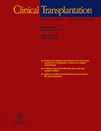Antibody-mediated rejection of renal allograft in combined liver–kidney transplant
No financial support was provided to conduct this work.
Abstract
Barth RN, Campos L, Kukuruga DL, Drachenberg C, Philosophe B. Antibody-mediated rejection of renal allograft in combined liver–kidney transplant.Clin Transplant 2009 DOI: 10.1111/j.1399-0012.2009.01161.x© 2009 John Wiley & Sons A/S.
Abstract: Liver transplantation is performed based on ABO blood type compatibility without dependence on crossmatch results. Combined liver–kidney transplantation (CLKT) is similarly performed without dependence of crossmatch results as the liver is thought to confer protection to the renal allograft against alloantibody. We report a case of CLKT in a sensitized patient with antibody-mediated rejection (AMR) of the renal allograft. AMR was confirmed with C4d staining and serial monitoring of donor-specific antibody (DSA). Despite intensive therapy directed against AMR and the presence of the liver allograft, the patient demonstrated increasing titers of alloantibody, never demonstrated adequate renal function, and ultimately expired after two months. This result demonstrates the potential for AMR of the renal allograft in sensitized recipients of CLKT.




